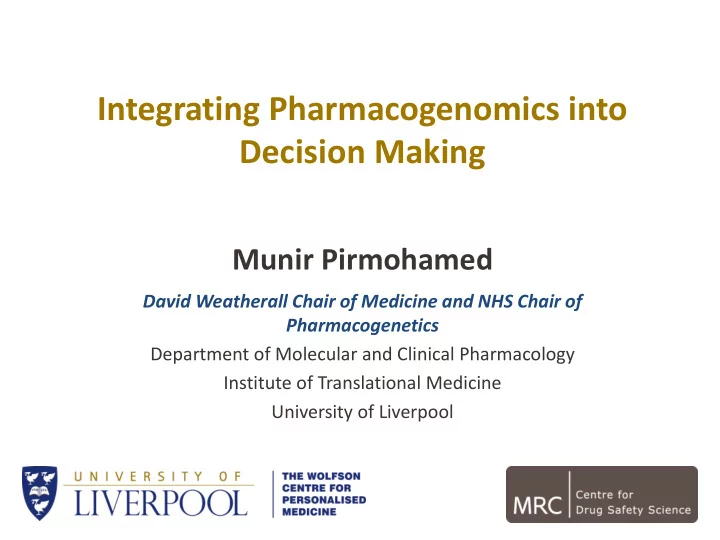

Integrating Pharmacogenomics into Decision Making Munir Pirmohamed David Weatherall Chair of Medicine and NHS Chair of Pharmacogenetics Department of Molecular and Clinical Pharmacology Institute of Translational Medicine University of Liverpool
Definitions Pharmacogenetics (after Vogel, 1957) The study of variations in DNA sequence as related to drug response ICH Topic E15, Pharmacogenomics November 2007 (after Marshall, 1997) The study of variations of DNA and PGx is a part of the drive towards precision RNA characteristics as related to medicine drug response
Regulatory Decision Making Benefit Based on population data Risk Benefit Based on individual/small group data Risk Moving closer to what happens in the clinic
15% of EMA evaluated medicines containing PGx information Therapeutic indication (3.5%) Posology and method of administration(4.4%) Contraindications (6.4%) Number of PGx biomarkers increasing
EMA SmPCs With Mandatory Genomic Testing Only 3 drugs outside the cancer area
US labels: Presented more PGx subheadings (51 vs 26%) More prevalence and PK data for each phenotype More information about dose modification Need for more harmonization 75% of US labels scored higher
119 drug-biomarker combinations 43 (36.1%) had convincing clinical validity evidence 18 (15.1%) evidence of clinical utility 61 labels (51.3%) – clinical decisions based on results of biomarker test: 36 (30%) contained convincing clinical utility data “It may be premature to include biomarker testing recommendations in drug labels when convincing data that link testing to patient outcomes do not exist.”
Drug Development and Companion Diagnostics Co-development of targeted drug with a companion diagnostic Usually evidence based on randomised controlled trials and reflected in the label Guidance available from EMA and FDA Looking to the future: With single biomarkers, tests from multiple providers can pose issues in terms of analytic validity We may be moving from single biomarkers to biomarker panels or ultimately to next generation sequencing Regulation of such multiple biomarker panels will be challenging – single provider, multiple providers etc? Debate on how to regulate next generation sequencing.
New CF drug, ivacaftor Targets G551D mutation in the CFTR gene (4% of CF population) Fantastic innovation with increases in FEV1 ~10% • 200 scientists • 600,000 compounds screened • In silico screening of 2.7 million compounds • 3 possible candidates Indication expanded in 2014: G178R, S549N, S549R, G551S, G1244E, S1251N, S1255P, and G1349D
The Evidence Hierarchy RCTs are top of the hierarchy Challenges: Smaller populations Multiple mutations Cost Existing drugs
Novel trial designs – acceptability for registration Umbrella trial – investigation of single tumour type but stratification by different mutations linked to specific candidate drugs Basket study – in multiple tumour types but with a focus on one or few biomarkers
Associations of Serious Adverse Drug Reactions with HLA Alleles
Carbamazepine Hypersensitivity N More complicated than abacavir C O hypersensitivity NH 2 Different phenotypes Skin (mild → blistering) Liver Systemic (DRESS) Predisposition varies with ethnicity and phenotype HLA-B*1502 (Chinese) HLA-A*3101 (Caucasian)
CPT, 2012 HLA-B*1502
Replicated in Japanese, • Chinese, South Korean, Canadian and EU populations NNT = 47 • SmPC/drug label • changed (for Liverpool information). NOT 22 patients with HSS MANDATORY
1 0.9 0.8 Probability of cost-effectiveness 0.7 0.6 0.5 Test No Test 0.4 0.3 0.2 0.1 0 0 5000 10000 15000 20000 25000 30000 35000 40000 45000 50000 Cost-effectiveness threshold (£ / QALY) Epilepsia 2015
Treating Patients with Renal Impairment Narrow Advice in drug Renal therapeutic label to reduce elimination index dose • Degree of dose reduction based on PK (occasionally with PD) modelling • RCTs not usually done Accepted as standard practice by clinicians • • Implementation helped by ready availability of renal function tests • Genetic polymorphism with the same effect size usually not acted upon • Lack of availability of tests may be one factor
• €15 million, H2020, 10 EU countries • Implement pre-emptive PGx testing in a real world clinical setting across 7 EU sites Evaluate patient outcome and cost effectiveness using • solid scientific methodology • Start 1-1-2016, 5 years • Consortium members: • H-J Guchelaar (Coordinator), • M van Rhenen, KC Cheung, KNMP JJ Swen, M Kriek, LUMC C Mitropoulou, GHXF • • • M Pirmohamed, R Turner, UOL • D Steinberger, BIOL • J Stingl, FDMD • CL Davila Fajardo, SAS • M Ingelman-Sundberg, KI • G Patrinos, UPAT • M Karlsson, S Jỏnsson, PBUU • V Dolz̍ an, ULMF M Schwab, E Schaeffeler, IKP A Cambon-Thomsen, UPS • • • VHM Deneer STZHM • G Toffoli, E Cecchin, CROA • M Samwald, G Sunder-Plassmann, MUWV
Project Outline N=8,000
100,000 Genomes Project in England A transformational project for the NHS to embed genomic medicine into practice 100,000 genomes from 70,000 individuals Accompanied by Genomics England Clinical Interpretation Partnerships (to undertake research) - GeCIP Pharmacogenomics sub-domain GeCIP to explore issues related to PGx variants
The Only Thing That Is Constant Is Change Heraclitus (535BC - 475BC)
Recommend
More recommend